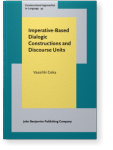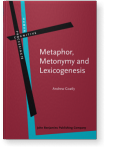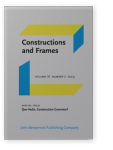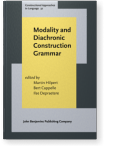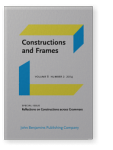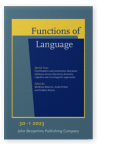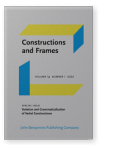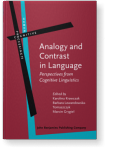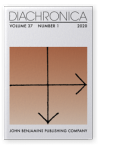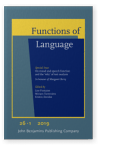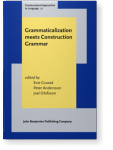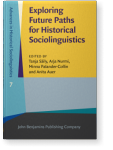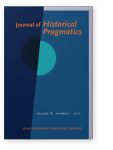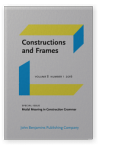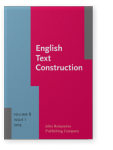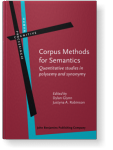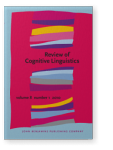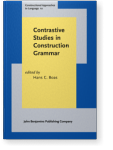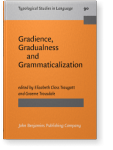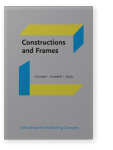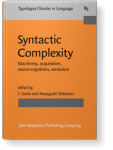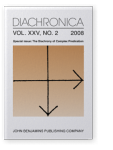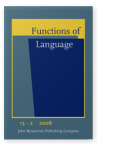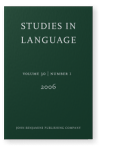Martin Hilpert
List of John Benjamins publications for which Martin Hilpert plays a role.
Book series
ISSN 1573-594X
Journals
ISSN 1876-1933 | E-ISSN 1876-1941
ISSN 0929-998X | E-ISSN 1569-9765
Broadening the Spectrum of Corpus Linguistics: New approaches to variability and change
Edited by Susanne Flach and Martin Hilpert
[Studies in Corpus Linguistics, 105] 2022. vi, 321 pp.
Subjects Corpus linguistics | Theoretical linguistics
Modality and Diachronic Construction Grammar
Edited by Martin Hilpert, Bert Cappelle and Ilse Depraetere
[Constructional Approaches to Language, 32] 2021. v, 251 pp.
Subjects Historical linguistics | Semantics | Syntax | Theoretical linguistics
Constructions across Grammars
Edited by Martin Hilpert and Jan-Ola Östman
[Benjamins Current Topics, 82] 2016. v, 206 pp.
Subjects Syntax | Theoretical linguistics
Reflections on Constructions across Grammars
Edited by Martin Hilpert and Jan-Ola Östman
Special issue of Constructions and Frames 6:2 (2014) v, 201 pp.
Subjects Cognition and language | Functional linguistics | Syntax | Theoretical linguistics
Germanic Future Constructions: A usage-based approach to language change
Martin Hilpert
[Constructional Approaches to Language, 7] 2008. ix, 205 pp.
Subjects Cognitive linguistics | Germanic linguistics | Syntax | Theoretical linguistics
2024 The road ahead for Construction Grammar Quo Vadis, Construction Grammar?, Boas, Hans C., Jaakko Leino and Benjamin Lyngfelt (eds.), pp. 255–277 | Article
What does the future hold for Construction Grammar? What are the most promising future avenues for research on constructions? This paper addresses the development of Construction Grammar as a theory of language through the perspective of six recent PhD dissertations that explore constructional… read more
2024 Chapter 2. New approaches to investigating change in derivational productivity: Gender and internal factors in the development of ‑ ity and ‑ ness , 1600–1800 Crossing Boundaries through Corpora: Innovative corpus approaches within and beyond linguistics, Buschfeld, Sarah, Patricia Ronan, Theresa Neumaier, Andreas Weilinghoff and Lisa Westermayer (eds.), pp. 8–40 | Chapter
We study the productivity of the suffixes ‑ness and ‑ity in seventeenth‑ and eighteenth-century letters in the Corpora of Early English Correspondence. We analyze the role of gender and five internal factors: etymology, the word class of the base, branching structure, semantics, and occurrence… read more
2023 Editorial announcement Continuative and contrastive discourse relations across discourse domains: Cognitive and cross-linguistic approaches, Klumm, Matthias, Anita Fetzer and Evelien Keizer (eds.), pp. 1–3 | Editorial
2022 Introduction Broadening the Spectrum of Corpus Linguistics: New approaches to variability and change, Flach, Susanne and Martin Hilpert (eds.), pp. 1–5 | Chapter
2022 You don’t get to see that every day: On the development of permissive get Variation and Grammaticalization of Verbal Constructions, Czicza, Dániel and Gabriele Diewald (eds.), pp. 13–40 | Article
This paper contributes to the study of grammaticalization phenomena from the perspective of Construction Grammar (Coussé et al. 2018). It is concerned with modal uses of the English verb get that express a permitted action, as in The prisoners always get to make one phone call. Different views… read more
2022 Intersubjectification in constructional change Construction Grammar across Borders, Torrent, Tiago Timponi, Ely Edison da Silva Matos and Natália Sathler Sigiliano (eds.), pp. 95–118 | Chapter
This chapter addresses constructional change in a dialogical construction that is illustrated by utterances such as sarcastic much?, which typically serve the purpose of an interactional challenge. Drawing on web-based corpus data, we argue that this construction is currently undergoing a process… read more
2022 Chapter 9. A case of constructional contamination in English: Modified noun phrases influence adverb placement in the passive Analogy and Contrast in Language: Perspectives from Cognitive Linguistics, Krawczak, Karolina, Barbara Lewandowska-Tomaszczyk and Marcin Grygiel (eds.), pp. 283–302 | Chapter
This chapter discusses a case of what Pijpops and Van de Velde (2016) call constructional contamination. Specifically, we investigate the influence of English modified noun phrases on variation in adverb placement in the passive. On the basis of data from the COCA, we argue that highly frequent… read more
2021 Modality in Diachronic Construction Grammar: Long-standing questions, new perspectives Modality and Diachronic Construction Grammar, Hilpert, Martin, Bert Cappelle and Ilse Depraetere (eds.), pp. 1–11 | Chapter
2020 The great temptation: What diachronic corpora do and do not reveal about social change Corpora and the Changing Society: Studies in the evolution of English, Rautionaho, Paula, Arja Nurmi and Juhani Klemola (eds.), pp. 3–28 | Chapter
This paper examines the potential large diachronic corpora hold for the study of social change. Resources such as COHA or Google Books allow us to detect shifts in the frequencies of linguistic elements, which can then be interpreted as reflections of developments in society. This paper addresses… read more
2020 Unity and diversity in grammaticalization scenarios, Bisang, Walter & Andrej Malchukov Diachronica 37:1, pp. 127–132 | Review
2020 Intersubjectification in constructional change: From confrontation to solidarity in the sarcastic much? construction Construction Grammar across Borders, Torrent, Tiago Timponi, Ely Edison da Silva Matos and Natália Sathler Sigiliano (eds.), pp. 96–120 | Article
This paper addresses constructional change in a dialogical construction that is illustrated by utterances such as sarcastic much?, which typically serve the purpose of an interactional challenge. Drawing on web-based corpus data, we argue that this construction is currently undergoing a process… read more
2019 Preface On mood and speech function and the ‘why’ of text analysis: In honour of Margaret Berry, Fontaine, Lise, Miriam Taverniers and Kristin Davidse (eds.), pp. 1–4 | Editorial
2018 Three open questions in Diachronic Construction Grammar Grammaticalization meets Construction Grammar, Coussé, Evie, Peter Andersson and Joel Olofsson (eds.), pp. 21–39 | Chapter
A growing number of studies on language change adopt Construction Grammar as a theoretical framework so that there is now a developing field of Diachronic Construction Grammar. As is typical of any emerging linguistic theory, many aspects of Diachronic Construction Grammar are still not clarified… read more
2017 Historical sociolinguistics and construction grammar: From mutual challenges to mutual benefits Exploring Future Paths for Historical Sociolinguistics, Säily, Tanja, Arja Nurmi, Minna Palander-Collin and Anita Auer (eds.), pp. 217–237 | Chapter
This paper makes the case that Historical Sociolinguistics holds critical implications for Construction Grammar, which in return can contribute ideas to the study of sociolinguistic change. The relation of these approaches is discussed from two angles. On the one hand, there are theoretical and… read more
2017 A distributional semantic approach to the periodization of change in the productivity of constructions International Journal of Corpus Linguistics 22:4, pp. 490–520 | Article
This paper describes a method to automatically identify stages of language change in diachronic corpus data, combining variability-based neighbour clustering, which offers objective and reproducible criteria for periodization, and distributional semantics as a representation of lexical meaning.… read more
2017 Colloquialization in journalistic writing: The case of inserts with a focus on well Journal of Historical Pragmatics 18:1, pp. 104–135 | Article
Recent analyses of written text types have discovered significant frequency increases of colloquial or conversational elements, such as contractions, personal pronouns, questions or the progressive. This trend is often referred to as colloquialization. This paper presents a new perspective on… read more
2016 Change in modal meanings: Another look at the shifting collocates of may Modal Meaning in Construction Grammar, Cappelle, Bert and Ilse Depraetere (eds.), pp. 66–85 | Article
This paper discusses how modal auxiliaries fit into a constructional view of language and how this view allows us to think in new ways about diachronic meaning change in modal auxiliaries. These issues will be illustrated on the basis of a diachronic corpus-based study of the modal auxiliary may,… read more
2016 Reflections on Constructions across Grammars Constructions across Grammars, Hilpert, Martin and Jan-Ola Östman (eds.), pp. 1–6 | Article
2016 Constructional tolerance: Cross-linguistic differences in the acceptability of non-conventional uses of constructions Constructions across Grammars, Hilpert, Martin and Jan-Ola Östman (eds.), pp. 131–168 | Article
The present paper investigates the question whether different languages can be categorized into ‘constructionally tolerant’ languages, which grant speakers considerable freedom to combine syntactic constructions with lexical items in non-conventional ways, and ‘valency-driven’ languages, which… read more
2014 Review of Taylor (2012): The Mental Corpus. How Language is Represented in the Mind Discourse linguistics: Theory and practice, Aijmer, Karin and Anita Fetzer (eds.), pp. 119–126 | Review
2014 Collostructional analysis: Measuring associations between constructions and lexical elements Corpus Methods for Semantics: Quantitative studies in polysemy and synonymy, Glynn, Dylan and Justyna A. Robinson (eds.), pp. 391–404 | Article
This chapter offers a practical introduction to a set of corpus-linguistic analytical methods that are referred to collectively as ‘collostructional analysis’. The overarching aim in conducting a collostructional analysis is to find out which lexical items form collocations with a given grammatical… read more
2014 Reflections on Constructions across Grammars Reflections on Constructions across Grammars, Hilpert, Martin and Jan-Ola Östman (eds.), pp. 137–142 | Article
2014 Constructional tolerance: Cross-linguistic differences in the acceptability of non-conventional uses of constructions Reflections on Constructions across Grammars, Hilpert, Martin and Jan-Ola Östman (eds.), pp. 266–304 | Article
The present paper investigates the question whether different languages can be categorized into ‘constructionally tolerant’ languages, which grant speakers considerable freedom to combine syntactic constructions with lexical items in non-conventional ways, and ‘valency-driven’ languages, which… read more
2011 Dynamic visualizations of language change: Motion charts on the basis of bivariate and multivariate data from diachronic corpora International Journal of Corpus Linguistics 16:4, pp. 435–461 | Article
This paper uses diachronic corpus data to visualize language change in a dynamic fashion. Bivariate and multivariate data sets form the input for so-called motion charts, i.e. series of diachronically ordered scatterplots that can be viewed in sequence. Based on data from COHA (Davies 2010), two… read more
2010 An empirical approach to the use and comprehension of mixed metaphors Review of Cognitive Linguistics 8:1, pp. 66–92 | Article
So-called mixed metaphors have not received much attention in cognitive linguistic research, despite acknowledgments to the fact that the combination of metaphors is in fact pervasive. This paper makes the case that mixed metaphors present a unique test case for existing theories of metaphor, in… read more
2010 Comparing comparatives: A corpus-based study of comparative constructions in English and Swedish Contrastive Studies in Construction Grammar, Boas, Hans C. (ed.), pp. 21–42 | Article
2010 What can synchronic gradience tell us about reanalysis? Verb-first conditionals in written German and Swedish Gradience, Gradualness and Grammaticalization, Traugott, Elizabeth Closs and Graeme Trousdale (eds.), pp. 181–201 | Article
This paper discusses verb-first conditionals (Had I known this, I would have stayed at home) with regard to the hypothesis that the construction developed from a dialogual sequence into a hypotactic structure. While plausible, independent evidence for this scenario has been scarce. An alternative… read more
2009 The German mit-predicative construction Constructions and Frames 1:1, pp. 29–55 | Article
This paper discusses a usage pattern with German mit ‘with’ that is labelled here as the German mit-predicative construction. The pattern has been mentioned in previous research, but a usage-based constructional account is still missing. A qualitative analysis shows that the construction is… read more
2009 A quantitative approach to the development of complex predicates: The case of Swedish Pseudo-Coordination with sitta “sit” Syntactic Complexity: Diachrony, acquisition, neuro-cognition, evolution, Givón, T. and Masayoshi Shibatani (eds.), pp. 145–162 | Article
This paper traces the historical development of the Swedish Pseudo-Coordination construction with the posture verb sitta “sit”. In Swedish a small number of verbs, including posture verbs such as sitta, are used in coordination with another verb to convey that the described event has an extended… read more
2009 The co-evolution of syntactic and pragmatic complexity: Diachronic and cross-linguistic aspects of pseudoclefts Syntactic Complexity: Diachrony, acquisition, neuro-cognition, evolution, Givón, T. and Masayoshi Shibatani (eds.), pp. 215–238 | Article
This chapter examines the diachronic rise of a syntactically and pragmatically complex construction type: pseudoclefts. Given that cleft constructions combine available components of grammar — relative clauses and copular clauses — do they arise in full-fledged form? If they emerge gradually, what… read more
2008 A quantitative approach to the development of complex predicates: The case of Swedish Pseudo-Coordination with sitta “sit” The Diachrony of Complex Predication, Bowern, Claire (ed.), pp. 242–261 | Article
This paper traces the historical development of the Swedish Pseudo-Coordination construction with the posture verb sitta “sit”. In Swedish a small number of verbs, including posture verbs such as sitta, are used in coordination with another verb to convey that the described event has an extended… read more
2007 Chained metonymies in lexicon and grammar: A cross-linguistic perspective on body-part terms Aspects of Meaning Construction, Radden, Günter, Klaus-Michael Köpcke, Thomas Berg and Peter Siemund (eds.), pp. 77–98 | Article
This chapter investigates chained metonymies, which are metonymies that involve multiple conceptual shifts. Drawing on a survey of body part terms in a large balanced sample of languages, it explores which types of conceptual shifts give rise to extended lexical meanings, and which types are… read more
2007 Review of Fried & Östman (2004): Construction Grammar in a Cross-Language Perspective Studies in Language 31:2, pp. 479–485 | Review
2006 Auxiliaries in spoken Sinhala Functions of Language 13:2, pp. 229–253 | Article
This paper discusses whether there are elements in spoken Sinhala that can be appropriately labeled auxiliary verbs, adopting the framework of grammaticalization theory (Hopper and Traugott 1993). While auxiliaries are thought of as a nearly universal cross-linguistic category (Steele 1978), the… read more
2006 Review of Lindquist & Mair (2004): Corpus approaches to grammaticalization in English Studies in Language 30:1, pp. 225–229 | Review

